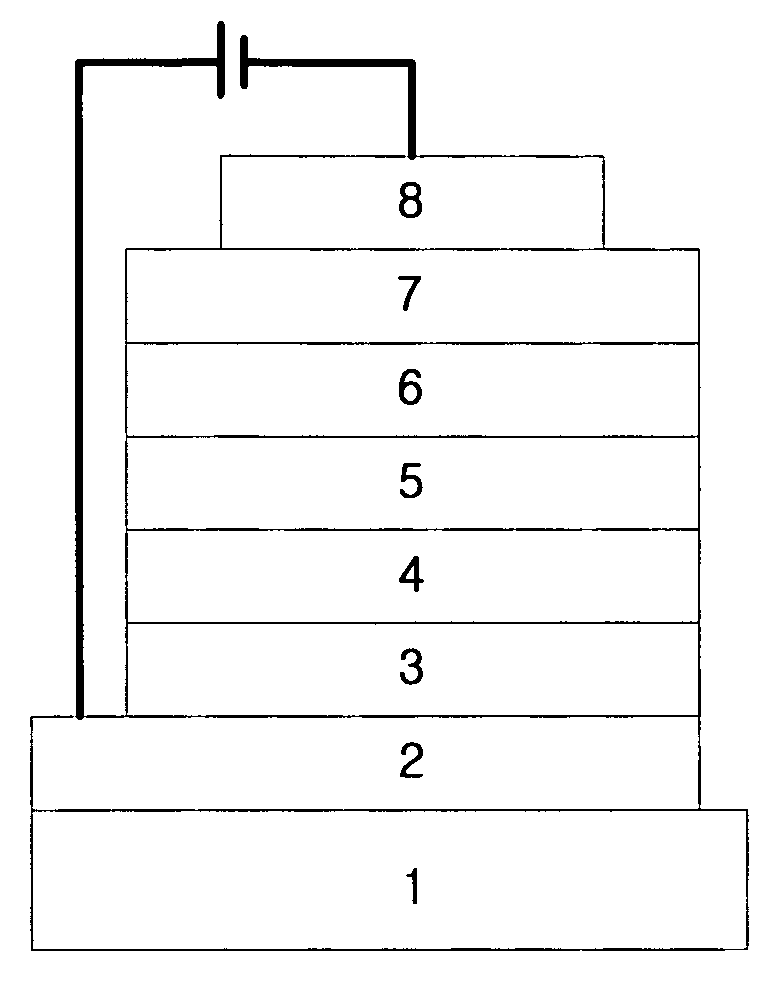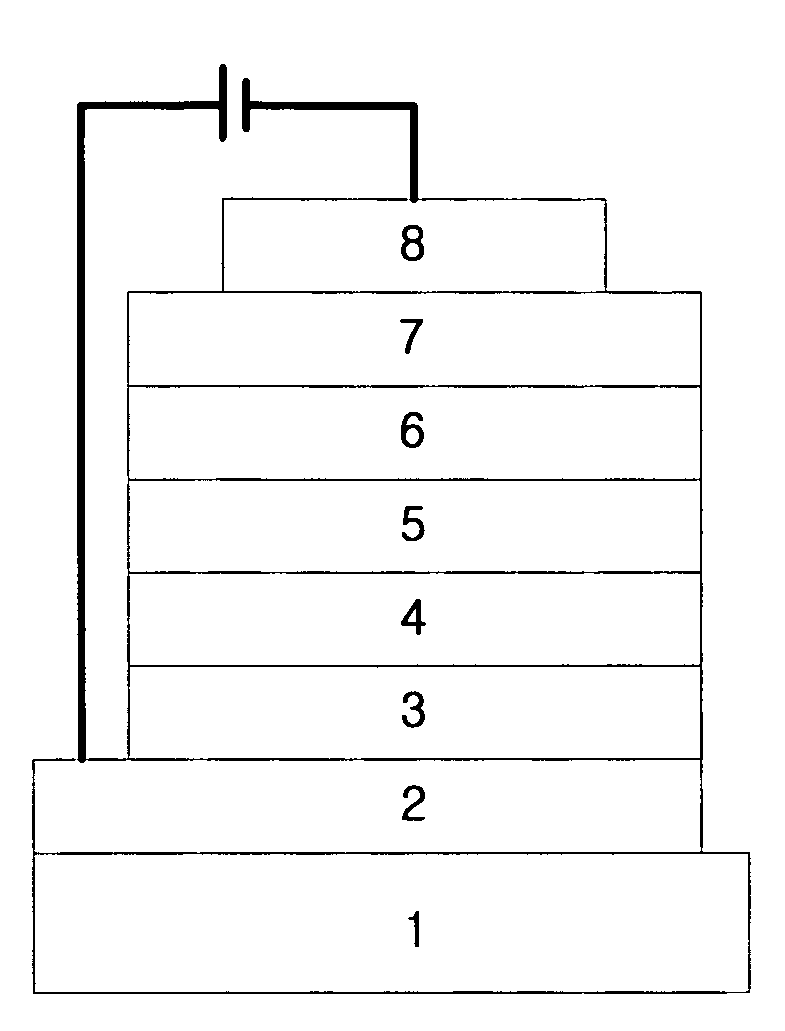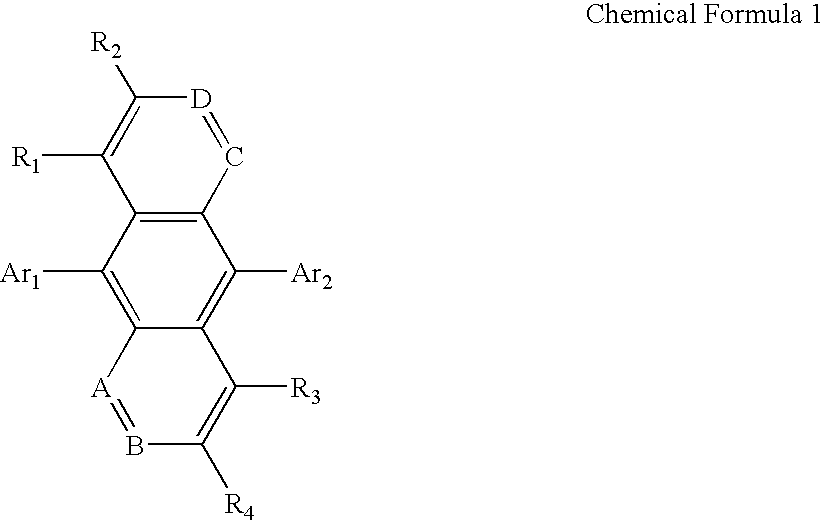Organic electroluminescent compounds and organic electroluminescent device using the same
a technology of organic electroluminescent devices and electroluminescent compounds, which is applied in the direction of discharge tube luminescnet screens, natural mineral layered products, etc., can solve the problems of difficult application of materials to display of high quality, urgent research and development of such materials, and merely a few thousand hours of life. , to achieve the effect of excellent luminous efficiency and improved lifetim
- Summary
- Abstract
- Description
- Claims
- Application Information
AI Technical Summary
Benefits of technology
Problems solved by technology
Method used
Image
Examples
preparation examples
Preparation Example 1
Preparation of Compound (8)
[0116]
Preparation of Compound (A)
[0117]Under nitrogen atmosphere, a 50 mL round-bottomed flask was charged with 3-bromopyridine (96 μL, 1 mmol) and diethyl ether (10 mL), and the mixture was stirred. After chilling the mixture to −78° C., butyllithium (2.5 mL, 1 mmol, 2.5 M in hexane) was slowly added thereto. After stirring for 1 hour at −78° C., dimethyl phthalate (0.17 mL, 1 mmol) was slowly added at the same temperature. After stirring at −78° C. for 2 hours, the temperature was slowly raised to room temperature, and water (5 mL) was added thereto to carry out hydrolysis. The organic layers obtained therefrom by extraction with ether were combined and dried. After removing the solvent, the residue was purified via column chromatography to obtain Compound (A) (0.14 g, 56%) as solid product.
Preparation of Compound (B)
[0118]Under nitrogen atmosphere, a 50 mL round-bottomed flask was charged with Compound (A) (0.11 g, 0.44 mmol) and TH...
preparation example 2
Preparation of Compound (383)
[0121]
Preparation of Compound (D)
[0122]Under nitrogen atmosphere, a 50 mL round-bottomed flask was charged with 2-bromopyridine (96 μL, 1 mmol) and diethyl ether (10 mL), and the mixture was stirred. After chilling the mixture to −78° C., butyllithium (2.5 mL, 1 mmol, 2.5 M in hexane) was slowly added thereto. After stirring at −78° C. for 1 hour, dimethyl phthalate (0.17 mL, 1 mmol) was slowly added at the same temperature. After stirring at −78° C. for 2 hours, the temperature was slowly raised to room temperature, and water (5 mL) was added thereto to carry out hydrolysis. The combined organic layer obtained therefrom by extraction with ether was dried. After removing the solvent, the residue was purified via column chromatography to obtain Compound (D) (0.14 g, 56%) as solid product.
Preparation of Compound (E)
[0123]Under nitrogen atmosphere, a 50 mL round-bottomed flask was charged with Compound (D) (0.11 g, 0.44 mmol) and THF (5 mL), and the mixture...
preparation example 3
Preparation of Compound (758)
[0126]
Preparation of Compound (G)
[0127]Under nitrogen atmosphere, a 50 mL round-bottomed flask was charged with 3-bromoquinoline (96 μL, 1 mmol) and diethyl ether (10 mL), and the mixture was stirred. After chilling the mixture to −78° C., butyllithium (2.5 mL, 1 mmol, 2.5 M in hexane) was slowly added thereto. After stirring at −78° C. for 1 hour, dimethyl phthalate (0.17 mL, 1 mmol) was slowly added at the same temperature. After stirring at −78° C. for 2 hours, the temperature was slowly raised to room temperature, and water (5 mL) was added thereto to carry out hydrolysis. The combined organic layer obtained therefrom by extraction with ether was dried. After removing the solvent, the residue was purified via column chromatography to obtain Compound (G) (0.14 g, 56%) as solid product.
Preparation of Compound (H)
[0128]Under nitrogen atmosphere, a 50 mL round-bottomed flask was charged with Compound (G) (0.11 g, 0.44 mmol) and THF (5 mL), and the mixtur...
PUM
| Property | Measurement | Unit |
|---|---|---|
| electroluminescent peak at wavelength | aaaaa | aaaaa |
| external quantum efficiency | aaaaa | aaaaa |
| electroluminescent peak of wavelength | aaaaa | aaaaa |
Abstract
Description
Claims
Application Information
 Login to View More
Login to View More - R&D
- Intellectual Property
- Life Sciences
- Materials
- Tech Scout
- Unparalleled Data Quality
- Higher Quality Content
- 60% Fewer Hallucinations
Browse by: Latest US Patents, China's latest patents, Technical Efficacy Thesaurus, Application Domain, Technology Topic, Popular Technical Reports.
© 2025 PatSnap. All rights reserved.Legal|Privacy policy|Modern Slavery Act Transparency Statement|Sitemap|About US| Contact US: help@patsnap.com



